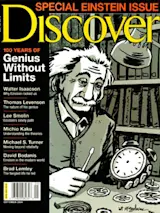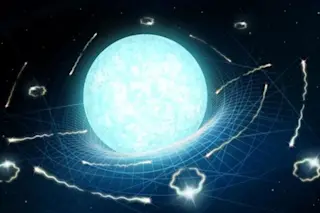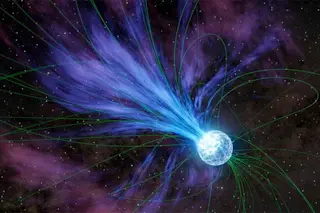Albert Einstein got it wrong. Not once, not twice, but countless times. He made subtle blunders, he made outright goofs, his oversights were glaring. Error infiltrated every aspect of his thinking. He was wrong about the universe, wrong about its contents, wrong about the workings of atoms. Yet Einstein’s mistakes could be compelling and instructive, and some were even essential to the progress of modern physics. “Most scientists would give their eyeteeth to make even one of Einstein’s mistakes,” says theoretical physicist Fred Goldhaber of the State University of New York at Stony Brook.
But they were still mistakes. In 1911 Einstein predicted how much the sun’s gravity would deflect nearby starlight and got it wrong by half. He rigged the equations of general relativity to explain why the cosmos was standing still when it wasn’t. Beginning in the mid-1920s, he churned out faulty unified field theories at a prodigious rate. American physicist Wolfgang Pauli complained that Einstein’s “tenacious energy guarantee[s] us on the average one theory per annum,” each of which “is usually considered by its author to be [the] ‘definitive solution.’ ” And, while other physicists built careers describing the random antics within atoms, Einstein never even allowed that God might play dice with the universe.
Einstein’s blunders reveal the unique mind behind his winning thoughts. Einstein’s mistakes get upstaged by a few of his good ideas. Still, his errors deserve scrutiny, and not just for the schadenfreude. “There is no logical path to these laws; only intuition . . . can reach them,” Einstein said. In retrospect, however, his discoveries seem eminently logical. Only his errors preserve the doubts, quirks, and prejudices that fed his intuition. If his triumphs describe how the universe works, then his mistakes describe how he worked.
In 1916 Einstein found what he considered a glitch in his new theory of general relativity. His equations showed that the contents of the universe should be moving— either expanding or contracting. But at the time, the universe seemed the very definition of stasis. All the data, facts, and phenomena known in the early 1900s said that the Milky Way was the cosmos itself and that its stars moved slowly, if at all. Einstein had presented the definitive version of the general theory of relativity to the Prussian Academy of Sciences the previous year, and he was not inclined to retract it. So he invented a fudge factor, called lambda, that could function mathematically to hold the universe at a standstill. The term implied that space itself had energy that resisted the contraction caused by gravity or the expansion from the stretching of space.
Lambda “was not justified by our actual knowledge of gravitation,” Einstein said. But he stood by the ideal of the unchanging heavens until the moment, in 1929, when American astronomer Edwin Hubble discovered that the universe is expanding.
Einstein later called lambda his greatest blunder. But a greater embarrassment—with the benefit of hindsight—was his failure to predict universal expansion. He should have questioned the plausibility of a paralyzed universe, says emeritus physicist James Peebles of Princeton University: “A static universe isn’t physically self-consistent. The sun can’t shine forever. He didn’t recognize that, and I’ve always found that startling.”
EINSTEIN’S GREATEST MISTAKE
Gμv – λg = - κ (Tμv – 1/2gμvT)
THE COSMOLOGICAL CONSTANT: LAMBDA
In 1917 Einstein published an equation that described an expanding universe. But he inserted a fudge factor called lambda (in yellow) to allow the equation to describe a static universe. In 1929 Edwin Hubble found that the universe is, in fact, expanding.
Some of Einstein’s peers recognized it in the master’s own equations. When Dutch astronomer Willem de Sitter pointed out that one interpretation of general relativity looked awfully like an expanding universe, Einstein sought a flaw in his reasoning. Russian mathematician Alexander Friedmann showed that general relativity explicitly posits a cosmos in motion; Einstein responded by publishing a short note claiming that the analysis was downright wrong. In a second paper, he conceded that the model was mathematically correct but dismissed it as physically absurd.
Why was Einstein so set on an immobile universe? Part of his insistence may have been fatigue. He had just completed the last mile of a decadelong intellectual marathon that made his earlier breakthroughs—special relativity, say, or the discovery of light quanta—look like a sprint. General relativity was the first, and remains the only, theory capable of uniting space, time, mass, energy, motion, and light in a grand vision of the nature and the fate of the cosmos. Its formulation had cost Einstein so much effort that it quite literally made him ill—he collapsed with stomach pains and lost more than 50 pounds in the winter and spring of 1917.
“You have to remember, he started the game. He did all the heavy lifting,” says Goldhaber. “He said, ‘Let’s make a model of the universe.’ Nobody else even had the tools to begin that. He couldn’t be expected to get it all right.”
Einstein never questioned the longstanding evidence for a static universe, even when new observations gave the first hints of expansion. When de Sitter showed him data from the Lowell Observatory in Arizona that suggested distant nebulas were speeding away in all directions, Einstein balked: OK, quasi-stationary then, he said. Einstein was as much an aesthete as a scientist, and he seemed to have a fundamentally aesthetic reason for preferring a stable cosmos. Although he never fully articulated it, this instinct for beauty would surface again and again in his very particular sense of how a proper law of physics worked, what proper math looked like, and the way nature should operate. He gave primacy to “free inventions of the mind,” as he called them, which were aloof from facts and phenomena. The German mathematician Felix Klein accused Einstein of working “under the influence of obscure physical-philosophical impulses.”
Those impulses drove his imagination beyond common sense and ordinary insight to radical and fundamental truths. But he sometimes turned against the daring implications of his ideas—especially when such implications were presented by someone else. General relativity provoked a welter of secondhand analyses, and it seemed to gall Einstein to watch other theoreticians spin webs of sticky perplexities from the silk of his great achievement. He was often disapproving of the claims colleagues made based on his equations. “In my personal experiences I have rarely learned better to know the shadiness of people than in connection with this theory,” he wrote to a friend.
Einstein objected when one colleague dared use general relativity—a geometric description of pliant space-time—to predict a cosmic phenomenon in which space, time, and the laws of relativity cease to exist. The phenomenon is now known as a black hole.
The German astrophysicist Karl Schwarzschild spent the early years of World War I on the eastern front, calculating ballistics trajectories for artillery units. He used his spare time to vet old astronomical problems with the new metric of general relativity. One exercise considered what would happen if a star were radically compressed into an infinitesimal volume. Schwarzschild’s results showed that, at some critical density, the star’s gravity would become so strong that it would swallow everything—matter, light, even space and time—within a specific radius. Schwarzschild thus developed a mathematical description of black holes decades before they were observed or understood.
Einstein never took the idea seriously. “He thought they were an artifact, a sloppy application of the equations,” says Peebles. Mathematically, a black hole is a so-called singularity—a place where space and time become so distorted that the equations of general relativity yield infinities, rather than rational numbers, as solutions. To Einstein, infinity was no answer at all—it was a failure. He could believe in gravity waves and other unlikely predictions of general relativity because math supported them. Black holes defied math. He called Schwarzschild’s results “a true disaster.”
General relativity was Einstein’s favorite “free invention.” He was confident it could describe the behavior of every object in the universe. Thus he claimed, somewhat tautologically, that any instance in which his equations failed could not actually represent nature. “Einstein didn’t think that [Schwarzschild’s] solution corresponded to anything real,” says theoretical physicist Frank Wilczek of MIT.
Einstein had merely to step into another viewpoint to reconcile the apparent singularity with his philosophical beliefs, says Wilczek. Yet the man who knew the most about relativity failed to regard Schwarzschild’s solutions from a different vantage point. To an observer trapped within a black hole, the laws of general relativity still obtain. In fact, all the laws of physics would appear to function as usual. “We could be in a black hole right now and not know it,” Wilczek says.
That is an idea worthy of Einstein.
“The most beautiful experience we can have is the mysterious,” Einstein once wrote. Yet when his thinking revealed one of the most notorious paradoxes of the physical world, he ultimately shunned it. The mystery has to do with the nature of light. Experiments conducted at the start of the century had shown that light shining on a metal plate produced showers of electrons whose speed, or energy, was the same no matter how bright the light. Einstein explained the so-called photoelectric effect by asserting that light, which was known to flow in continuous waves, could also be regarded as sputtering along in discrete particles, or quanta. Each of these particles—every quantum of light at a given wavelength—carried the same amount of energy, he argued, and so dispatched a single electron with the same energetic kick. Thus did Einstein discover the photon. He lived to regret it.
The wave-particle duality was unsettling enough. But when Danish physicist Niels Bohr showed that the electrons in atoms, too, must behave as quanta to account for observations, Einstein made a conceptual leap that troubled him even more. In pondering the quantum interactions between matter and light, Einstein found he could calculate neither the timing nor the direction of the photons spontaneously emitted from atoms. The emissions were fundamentally random. Chance seemed to be an ineluctable element of the quantum world.
In fact, quantum theory suggests that random events are rampant at the subatomic level. There is no way to predict cause and effect on a case-by-case basis. The best that physicists can do is calculate probabilities, which do or do not prove out for a large number of events. To Einstein, a statistical probability was even less acceptable than the infinities of a singularity. A physics that could not predict individual events was no physics at all, he said. It was, at best, guesswork. And it certainly did not correspond to reality, which, like the universe, Einstein preferred to see as stable, orderly, and knowable to the most intimate detail. Apparently, he regarded mysteries as beautiful only if they offered some hope of solution.
“[T]hat he would choose to play dice with the world,” Einstein wrote [of God], “is something that I cannot believe for a single moment.” Bohr supposedly replied, “Stop telling God what to do.” But the aesthete in Einstein turned his back on quantum theory.
A new generation of physicists rushed to embrace it. In the 1920s quantum mechanics became the rage, and it advanced by leaps and bounds, thanks in large part to Einstein’s persistent efforts to discredit it. At the famous Solvay conferences in 1927 and 1930, Einstein challenged his friend Bohr, the chief proponent of quantum mechanics, with thought experiments meant to reveal logical contradictions in the theory. At first Bohr would be devastated, but he always managed to produce an answer to Einstein’s critique. By the 1930s quantum mechanics had become intellectually unassailable. The vast majority of physicists today believe that the subatomic realm really is, in some sense, unknowable.
Einstein eventually relaxed his vigilance, but he never accepted quantum mechanics as truth. “The more successes the quantum theory enjoys, the sillier it looks,” he said. With its wave-particle paradox, the theory offended his aesthetic sensibilities; with its irreducible randomness, it impugned his scientific potency; with its popularity among the younger crowd, it may have triggered some very human aversion in an aging icon.
“He had dominated fundamental physics from 1905 to 1915, with an extraordinary series of insights,” Wilczek says. “And then he continued to dominate for 10 years more. To be competing with young whippersnappers would not be a very appealing prospect for a scientist of his stature.”
Einstein seemed to agree. “Truly new things one finds only in one’s youth,” he once opined. “Later one becomes more experienced, more famous, and dumber.”
In the last decades of his life, Einstein chose to work far from the madding crowd of quantum enthusiasts. He followed the mathematics of general relativity toward what he hoped would be a theory subsuming the laws of gravity and subatomic particles. He would recognize this unified theory, he said, by its beauty or self-evident rightness. He never came close to finding it, but he never doubted that someone would. “I cannot base this conviction on logical reasons,” he said. “My only witness is the pricking of my little finger.”
Some might call his last, fruitless quest a mistake too. But it’s a mistake other physicists are more than willing to emulate. The theory of everything, the deeper truth that unites all the forces of nature, that pulls cosmology and quantum theory together, remains the most important quest of physics. No one has pursued Einstein’s peculiar approach, but before his efforts are dismissed, it may be instructive to consider the eventual fate of Einstein’s self-proclaimed greatest blunder, lambda.
Lambda, also known as the cosmological constant, has come in handy of late. In the last decade astronomers discovered the expanding universe is also accelerating—expanding faster and faster. That confounding scenario can be represented mathematically if general relativity includes a term, just like the cosmological constant, that imbues empty space with an unidentified force. “Making use of the cosmological constant is by now a venerable aspect of contemporary cosmology,” says Fred Goldhaber.
The day may come when all of Einstein’s blunders seem equally prescient.














